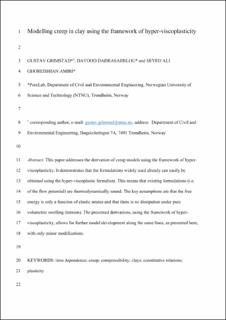| dc.contributor.author | Grimstad, Gustav | |
| dc.contributor.author | Dadrasajirlou, Davood | |
| dc.contributor.author | Ghoreishian Amiri, Seyed Ali | |
| dc.date.accessioned | 2021-02-02T14:04:21Z | |
| dc.date.available | 2021-02-02T14:04:21Z | |
| dc.date.created | 2020-12-09T09:16:18Z | |
| dc.date.issued | 2020 | |
| dc.identifier.citation | Géotechnique Letters. 2020, 10 (3), 404-408. | en_US |
| dc.identifier.issn | 2045-2543 | |
| dc.identifier.uri | https://hdl.handle.net/11250/2725862 | |
| dc.description.abstract | This paper addresses the derivation of creep models using the framework of hyper-viscoplasticity. It demonstrates that the formulations widely used already can easily be obtained using the hyper-viscoplastic formalism. This means that existing formulations (i.e. of the flow potential) are thermodynamically sound. The key assumptions are that the free energy is only a function of elastic strains and that there is no dissipation under pure volumetric swelling (tension). The presented derivations, using the framework of hyper-viscoplasticity, allows for further model development along the same lines, as presented here, with only minor modifications. | en_US |
| dc.language.iso | eng | en_US |
| dc.publisher | ICE Publishing | en_US |
| dc.title | Modelling creep in clay using the framework of hyper-viscoplasticity | en_US |
| dc.type | Peer reviewed | en_US |
| dc.type | Journal article | en_US |
| dc.description.version | acceptedVersion | en_US |
| dc.subject.nsi | VDP::Geoteknikk: 513 | en_US |
| dc.subject.nsi | VDP::Geological engineering: 513 | en_US |
| dc.source.pagenumber | 404-408 | en_US |
| dc.source.volume | 10 | en_US |
| dc.source.journal | Géotechnique Letters | en_US |
| dc.source.issue | 3 | en_US |
| dc.identifier.doi | 10.1680/jgele.20.00004 | |
| dc.identifier.cristin | 1857760 | |
| dc.description.localcode | | en_US |
| cristin.ispublished | true | |
| cristin.fulltext | postprint | |
| cristin.qualitycode | 1 | |
